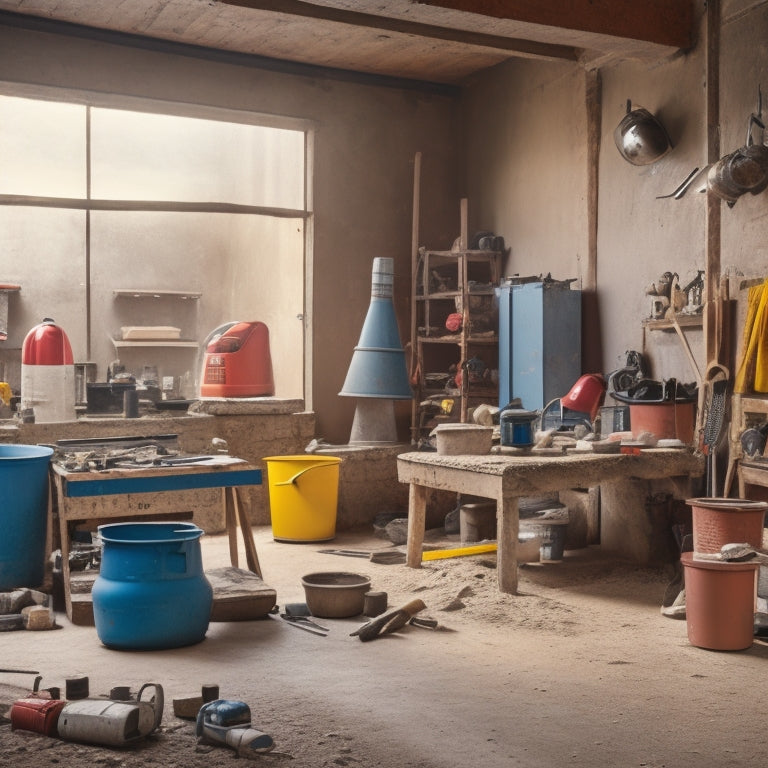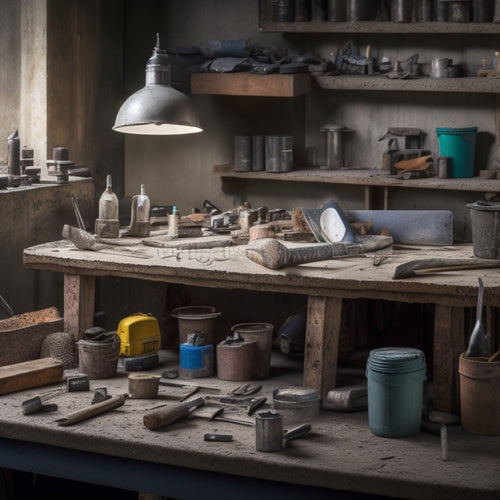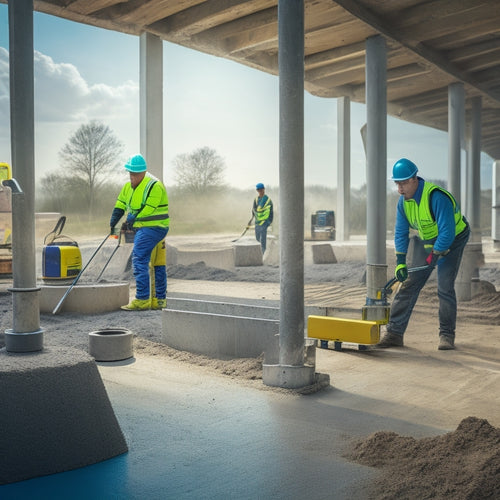
What Tools Do Concrete Homeowners Need Most
Share
You'll need a range of specialized tools to maintain your concrete home, from crack fillers and sealing compounds to moisture meters, pressure washers, and humidity control systems. Crack repair tools, like epoxy and polyurethane, are essential for addressing cracks promptly. Regular cleaning tools, such as stiff-bristled brooms and degreasers, keep concrete surfaces clean and safe. Moisture management tools, including moisture sensors and vapor barriers, combat damage from moisture. With these tools, you'll be well-equipped to identify and address issues early, ensuring your home remains safe and intact. By exploring these tools further, you'll reveal a thorough maintenance strategy.
Key Takeaways
• Crack fillers and sealing compounds are essential for addressing cracks and preventing water infiltration and further damage.
• Moisture meters and humidity control tools, such as dehumidifiers and hygrometers, help detect and manage moisture levels.
• Stiff-bristled brooms, pressure washers, and degreasers are necessary for regular cleaning and maintenance of concrete surfaces.
• Silicone-based sealants and polyurethane are vital for joint and sealant maintenance to prevent water infiltration and cracking.
• Drainage solutions, such as French drains and perimeter drains, are crucial for redirecting water away from the home's foundation.
Foundation Inspection Essentials
When buying or maintaining a concrete home, you need to inspect the foundation regularly to catch potential issues before they become major problems. Foundation inspection techniques are vital in identifying signs of damage, wear, or settlement that can compromise the structural integrity of your home. As a concrete homeowner, it's important to know what to look for during these inspections.
Start by visually examining the foundation walls, piers, and footings for cracks, water damage, or signs of erosion. Check for any shifting or unevenness in the walls, floors, or ceilings, which can indicate foundation settlement or movement. You should also look for signs of water damage, such as stains, rust, or mineral deposits, which can weaken the foundation over time.
In addition to visual inspections, consider hiring a professional to conduct structural integrity assessments, which may involve non-destructive testing methods like thermal imaging or acoustic emission testing. These assessments can help identify hidden issues, such as foundation cracks or voids, and provide valuable insights for repairs or maintenance.
Crack Repair and Sealing
After identifying cracks in your concrete home's foundation during a thorough inspection, you'll need to address these issues promptly with effective crack repair and sealing techniques to prevent water infiltration and further damage.
Cracks can be a major concern, as they provide an entry point for water, which can cause erosion, freeze-thaw damage, and structural issues.
To tackle this, you'll need a range of tools and materials, including crack fillers and sealing compounds. These products come in various forms, such as epoxy-based injectable fillers, polyurethane foams, and acrylic-based sealants.
When selecting a product, consider factors like the crack's width, depth, and location, as well as the surrounding environment. It's crucial to choose a product that's compatible with your concrete type and can withstand local climate conditions.
Cleaning Concrete Surfaces
Properly cleaning your concrete surfaces is essential to maintaining their appearance, longevity, and safety, as dirt, grime, and other substances can hide defects, compromise adhesion, and even create slip hazards. You need to remove dirt and stains regularly to prevent them from setting in. For effective cleaning, you'll need the right tools and techniques.
Here are some essential cleaning tools you should have:
-
A stiff-bristled broom or brush to sweep away debris
-
A pressure washer with a wide fan tip to remove dirt and grime
-
A concrete cleaner or degreaser for tough stains
-
A scrub brush or scrubber for agitating stubborn stains
-
A cleaner specifically designed for stain removal, such as oil-based or acid-based cleaners
Remember to always follow the manufacturer's instructions and take necessary safety precautions when cleaning your concrete surfaces.
Regular cleaning and stain removal will help maintain the appearance of your concrete and provide surface protection. By keeping your concrete clean, you'll be able to identify any potential issues early on and take corrective action to prevent further damage.
Joint and Sealant Maintenance
You'll need to regularly inspect and maintain your concrete joints and sealants to prevent water infiltration, reduce cracking, and assure the structural integrity of your concrete surfaces. This involves checking for signs of wear, damage, or deterioration in the sealants and joints. Look for cracks, gaps, or crumbling joint materials that can compromise the structure.
When selecting sealant types, consider the specific needs of your concrete surfaces. For example, silicone-based sealants are ideal for high-traffic areas, while polyurethane-based sealants are better suited for joints exposed to harsh weather conditions. Confirm you choose sealants compatible with your joint materials, such as polyurethane or epoxy-based sealants for concrete joints.
Proper maintenance also involves cleaning the joints and sealants regularly to prevent dirt and debris buildup. Use a pressure washer or a stiff-bristled brush to remove dirt and grime.
Pest Control and Prevention
As you maintain your concrete surfaces, it's equally important to keep pests from damaging them. Regular inspections can help you identify signs of pest infestation, such as holes, tunnels, or pest droppings.
It's essential to stay on top of pest control and prevention to make sure your concrete home remains structurally sound and visually appealing. In order to do this, you'll need to employ effective pest identification strategies.
Some key tools and techniques to take into account include:
-
Sealing any cracks or crevices to prevent pest entry
-
Installing physical barriers, such as metal mesh, to block pests
-
Using eco-friendly treatments, like diatomaceous earth or essential oils, to repel pests
-
Implementing integrated pest management (IPM) techniques, which combine physical, cultural, and biological controls
-
Conducting regular inspections and monitoring for signs of pest activity
Moisture Management Tools
As a concrete homeowner, you're likely aware that moisture can be a major culprit when it comes to damage and deterioration.
To combat this, you'll need the right tools in your arsenal, and that's where moisture management tools come in.
You'll want to contemplate implementing moisture barrier systems, drainage solutions, and humidity control methods to keep your home safe and secure.
Moisture Barrier Systems
Moisture barrier systems, an essential component of moisture management tools, prevent water and moisture from seeping into your concrete home's walls and foundation.
As a homeowner, you understand the importance of protecting your investment from water damage and structural issues. Moisture barrier systems provide a reliable solution to this problem.
To guarantee effective moisture management, consider the following components:
-
Moisture sensors: installed in the walls or foundation to detect moisture levels and alert you to potential issues.
-
Vapor barriers: impermeable materials that prevent moisture from migrating through the walls or foundation.
-
Drainage mats: designed to direct water away from the foundation and prevent accumulation.
-
Waterproofing membranes: applied to the exterior of the foundation to prevent water infiltration.
-
Capillary breaks: materials that prevent moisture from rising through the walls or foundation by capillary action.
Drainage Solutions Required
You'll need to incorporate drainage solutions into your moisture management strategy to guarantee that water is directed away from your concrete home's foundation and walls. This is essential to prevent water accumulation, which can lead to structural damage, mold growth, and other issues. A well-designed drainage system guarantees water flow is directed away from your home, reducing the risk of water seepage and damage.
To achieve effective drainage, consider the following solutions:
| Drainage Solution | Description |
| French Drains | A trench-filled drainage system that redirects water away from your home's foundation |
| Gutters and Downspouts | Collect and redirect rainwater away from your home's walls and foundation |
| Perimeter Drains | A drainage system installed around your home's perimeter to collect and redirect water |
Humidity Control Methods
Frequently, homeowners of concrete homes overlook the importance of humidity control methods, which are essential for maintaining a dry and healthy living space. As you know, excess moisture can lead to mold growth, structural damage, and indoor air quality issues. To avoid these problems, you need to implement effective humidity control methods.
Here are some essential tools to evaluate:
-
Dehumidifier options: Whole-house dehumidifiers, portable dehumidifiers, and crawl space dehumidifiers can help remove excess moisture from the air.
-
Humidity monitoring: Install hygrometers or thermohygrometers to track humidity levels and temperature, ensuring you're aware of any changes.
-
Ventilation systems: Proper ventilation systems, such as heat recovery ventilation (HRV) or energy recovery ventilation (ERV), can help exchange stale air for fresh air.
-
Moisture-resistant materials: Use moisture-resistant materials, like waterproof paints and coatings, to prevent water infiltration.
-
Regular inspections: Regularly inspect your home for signs of moisture damage, musty odors, or water stains to catch issues early.
Frequently Asked Questions
Can I Use Bleach to Clean My Concrete Surfaces?
You're wondering if bleach is the best bet for cleaning your concrete surfaces. The short answer is, it's not ideal. Bleach can damage the concrete's sealant and discolor the surface.
Instead, you should opt for bleach alternatives like oxygen-based cleaners or enzyme-based cleaners.
When it comes to concrete cleaning methods, always choose a gentle approach to avoid damaging the surface. A mild detergent and warm water usually do the trick.
How Often Should I Seal My Concrete Floors?
You're probably thinking, 'Do I really need to seal my concrete floors that often?' But trust us, it's worth the effort.
Sealing frequency depends on foot traffic and maintenance habits. For high-traffic areas, reapply every 2-3 years, while low-traffic areas can go 5-7 years between sealings.
Regular floor maintenance, like cleaning and drying, will help extend the sealant's lifespan. By sealing regularly, you'll protect your floors from stains and damage, ensuring they stay looking their best.
What Is the Best Way to Remove Oil Stains From Concrete?
When tackling oil stains on your concrete, you'll want to act fast to prevent them from setting in.
Try using oil absorption methods like baking soda or sawdust to soak up the spill.
Then, apply a stain prevention technique like a commercial cleaner or a homemade mixture of dish soap and hot water.
Let it sit before rinsing and scrubbing the area clean.
Remember to seal your concrete afterwards to prevent future stains from forming.
Can I Paint Over Existing Concrete Stains and Sealers?
A million times yes, you can paint over existing concrete stains and sealers!
However, it's vital to identify the stain types first - oil, rust, or organic - to choose the right prep work.
Make certain the sealer is fully cured and compatible with your new paint.
Research sealing options like epoxy, polyurethane, or acrylic to make certain of a strong bond.
Proper prep and selection will guarantee a durable, stain-free finish that'll make your concrete look brand new.
How Do I Know if My Concrete Is Porous or Non-Porous?
You're wondering if your concrete is porous or non-porous. To find out, you'll need to conduct a moisture testing and surface inspection.
Start by sprinkling water on the surface - if it absorbs quickly, it's porous.
Next, inspect the surface for signs of wear, cracks, or efflorescence. If you notice any of these, it's likely porous.
If not, it might be non-porous.
Conclusion
As a concrete homeowner, you've got a lot on your plate.
On one hand, you're enjoying the durability and low maintenance of your concrete home.
On the other hand, you're dealing with the harsh realities of cracks, pests, and moisture issues.
But with the right tools - from foundation inspection essentials to moisture management tools - you can stay on top of these problems and keep your home strong and secure for years to come.
Related Posts
-

7 Must-Have Tools for Concrete Repair Organization
To effectively organize your concrete repair projects, you'll need a thorough toolkit that includes a well-planned st...
-

Top Tools for Concrete Repair Success
When it comes to concrete repair success, you'll need a well-stocked toolkit with essential hand tools like trowels, ...
-

What Tools Ensure Precise Concrete Leveling Results
You need a range of specialized tools to achieve precise concrete leveling results. Laser leveling instruments provid...


